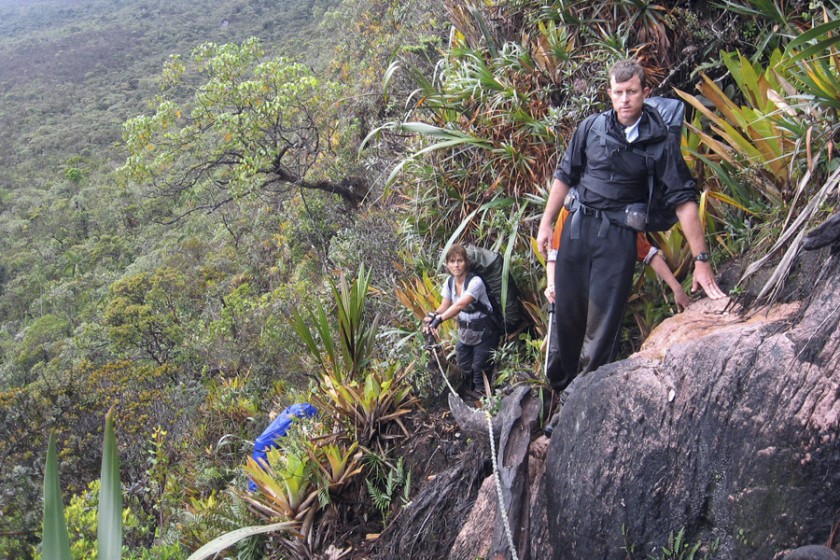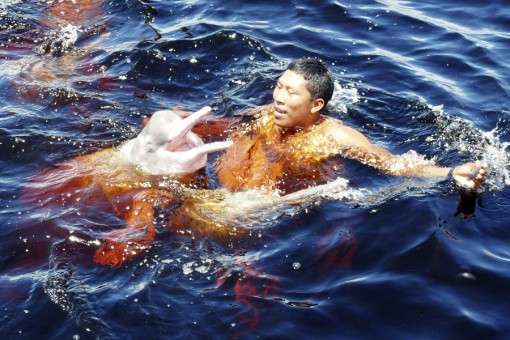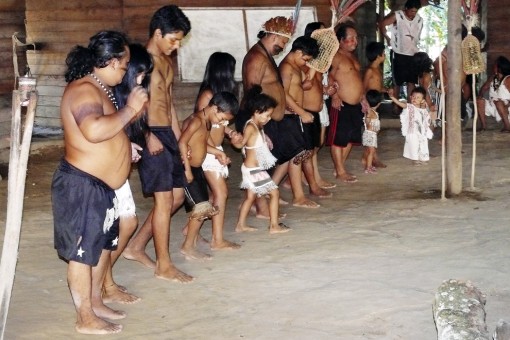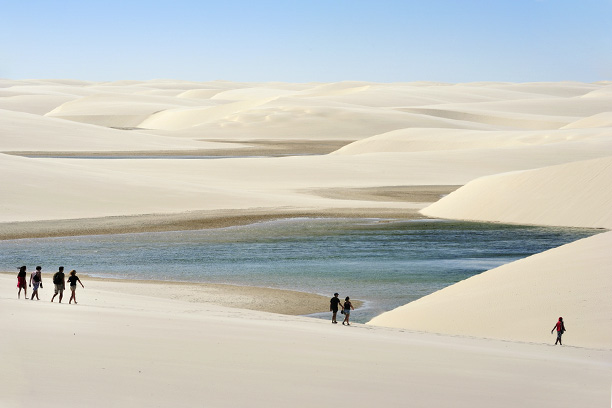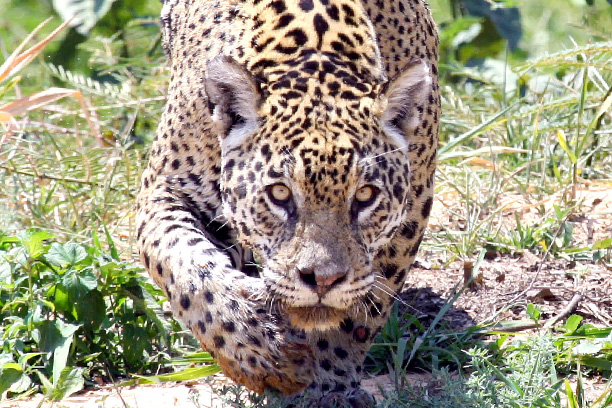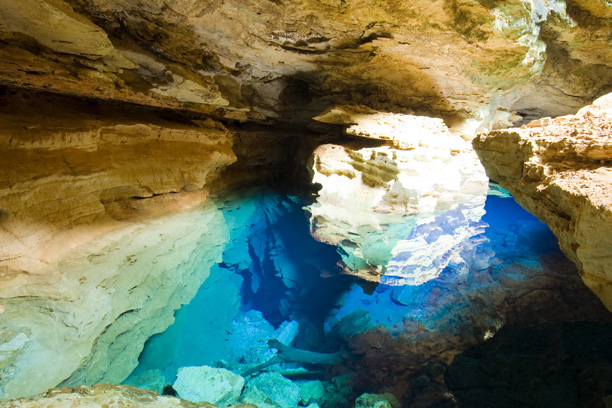overview
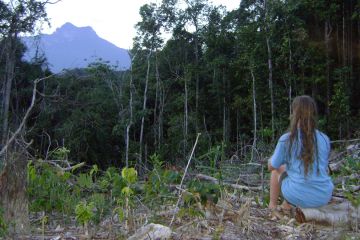
We have finally succeeded to re-start one of the most demanded expeditions of our days. Our Expedition to the Pico da Neblina offers outstanding experiences in the very deep of the Amazon Rain and Nebular Forest. If you like the real trekking adventure you should not miss out on the “Pico”.
The „Pico da Neblina” is located in the Imeri Massif, the deepest Amazonian Rainforest of Brazil, bordering with Columbia and Venezuela (0.8047° N, 66.0067° W). It is a nebular mountain and part of the Guyana shield, dating back to the Precambrian era. It is also the highest elevation in Brazil (2994 m).
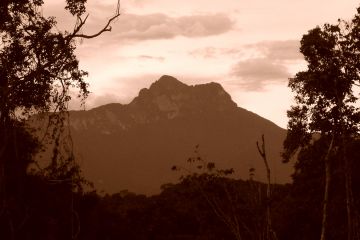
The hike to the top of the “Pico” is considered by experienced and hardened mountaineers one of the toughest anywhere. But hardship is forgotten when marveling at the diversity of the great variety in plant and animal live, starting with endemic species of carnivorous plants and flowers at altitudes of 2000 m, such as Heliamphora neblinae that are endemic here, Drosera montana and epiphytes, or the up to 5 m high spectacular Ericaceae, while in the lower areas you can find Ceiba pentandra Kapok trees which grow up to 70m high. The region is also home to animals like Jaguar and Tapir, reptiles, amphibious like Poison dart frog, and the new to Science Myersohyla chameleon, tarantulas, among many others.
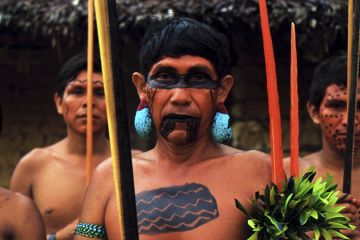
Your host are the famous yanomami indigenous people who will guide you to experience one of the great adventures of our time: the expedition to the “Pico da Neblina”. With this expedition we support the “Yaripo” project for sustainable tourism of the Yanomami organizations AYRCA and FOIRN
If you want to know more fascinating details about our Pico da Neblina Expedition you need to read the travelogue of Matthew and Armanda here:
Pico da Neblina: Trekking Brazil's Sacred Amazonian Peak with the Yanomami
travelogue
Amazon Journey to the northernmost frontier of the Brazilian rain and nebular forest
Who went along: two adventurers from Germany, a botanist from the Goeldi Amazon Research Centre, our guide and 3 porters
Belém, the capital of the of Amazonian state of Pará, in the Northeast of Brazil, is strategically located at the 250 km wide delta of the Amazon river. Since its foundations in 1616, it is considered to be the historical gateway to the Amazon region. Religious and other edifications date back to the colonial period and are maintained in good shape. Obviously we had to visit some of the highlights Belém offers to tourist and locals alike. At the famous market, the Mercado Ver-o-Peso (checking the weight market), we marvel at the exotic products displayed there. Enormous quantities of all kinds of sea-and river fishes are being offered and we wonder why there are no flies on them despite of the tropical heat all around us. There are also elixirs made from poisonous snakes and all imaginable and unimaginable kinds of medicinal herbs and fruits from the Amazon region.
We also visited the internationally renowned Goeldi Amazonian Research Institute with its botanical-zoological gardens representing exclusively species of that region a glimpse of the flora and fauna that we were to discover in the weeks to come...
We also took a trip on the Guamá river where we enjoyed typical food in one of the palm thatched restaurants, surrounded by luxurious nature. In the evening we went down to the harbour. The old piers and warehouses have been restored with shops, fancy bars and restaurants. Cargo cranes moved platforms back and forth under the ceiling, with artists performing excellent music shows. While we sat on the terrace in front of the river, we enjoyed draft beers made in the probably only in-house brewery of the whole Amazon region. A last delight before we should hit wilderness and suffering!
The following morning we took a flight to Manaus, the capital of the federal state of Amazonas. We had made plans to try to observe the South American jaguar Panthera onca at a spot some 80 km away from Manaus. To our disappointment we received information that, due to restrictions imposed by IBAMA, we were not permitted to enter the site. So we took the early flight on the next day to São Gabriel de Cachoeira where we arrived after two hours of flying over the "Green Hell" with its great and amazingly intricate river systems.
We checked in our modest hotel, to say the least, and walked over to IBAMA, the Brazilian Institute for the Environment to get permits for our expedition. We repeated the procedure at FUNAI, the Agency for the Protection of the Brazilian Indians, because our route leads across both the 2,200,000 hectares large national park of the Pico da Neblina and the Indian reservation area of the same name.
The village on the upper Rio Negro was founded in the middle of the 19th century as a military settlement and a Salesian mission. Today it consists of not much more than a Portuguese fortress with some dozen houses for soldiers and officers. The centrepiece of the village used to be the thatched church built in 1750, and which, since the beginning of the 20th century is the seat of the Salesian mission. The Brazilian Army and Air Force, supported by the federal police keep their jungle regiment here to safeguard the borders with Venezuela and Columbia and to track down on the intense drug and arms traffic in the area. The population consist in its majority of indigenous people of several tribes of the upper Amazon region.
The following morning, carrying all equipment, food and fuel supply, we work our way up by jeep along a treacherous jungle track to the mouth of the Rio Iá mirim. Final balance of the three-hour trip: stuck in the mud for six times!
After we stuffed our equipment and all our belongings into an aluminium boat and were ready to depart, the engine only whines out of pace and despite of all efforts, refused to do his job. Via satellite phone we ordered an extra engine for replacement, which postponed our departure for the following morning.
We used the time to visit the Indian settlement of the Tukano tribe, only a short walk away. We were shown how the main diet of all Indians in Brazil, the manioc roots, is being prepared by using different handcrafted tools. At the conviviality centre, the tribe gathers to discuss important day-to-day issues, as well as questions of social and political importance. The children receive bilingual education in their native and Portuguese language. School activities include both traditional cultural heritage and preparation for a life within a modern society. Apparently the kids had no problems to absorb these contradictions as they all looked happy and were very friendly toward us. In short, we gained a very interesting insight into the social organization of the tribe.
Common to the different tribes in the upper part of the Rio Negro is the language called Inheengatu, also known as general language which is spoken together with Portuguese. The Indians tribes of the upper and middle Rio Negro comprehend 18 ethnic groups with a total of about 35,000 Indians who live in 772 small villages. The largest and best known tribe is that of the Yanomamis, who alone live in a protected area of over 100,000 km².
We walked back to the Iá mirim river and prepared camp for the night at the FUNAI support base, right on the river banks. But before we could hit our hammocks we decided to undergo some serious testing of our skills as jungle adventurers. Incited by our hosts we took charge of some of the dugout canoes that lay around, but all our attempts resulted in total disaster. Those canoes are so shallow and small that at the slightest false movement they get filled with water, sinking in no time while the Tukano Indians on the shore shake with derisive laughter. Little wonder, as only they knew that in addition to our lack of awkwardness, the canoes leaked like hell from a couple of tiny holes that were invisible to us! Anyway, one:nil to the Indians! While recovering from our heroic efforts, Yanomami Indians arrived in their motorized canoes busily offloading ornamental fish of exotic colours and forms. Very appreciated by Ichthyologists the fish have been caught on the upper Tukano river and are being exported to everywhere in the world.
As we were standing there watching, one of us nearly stepped on a huge and hairy spider, the size of a palm. That nocturnal animal, scientifically named Theraphosa leblondi is the biggest spider in the world. Its life span may reach up to 20 years and it lives mainly in caverns of old tree trunks. Provoked it would jump on you and its bite causes terrible pain, but is not fatal.
The next morning greeted us with hundreds of yellow butterflies, that fluttered all around us. Unfortunately we could not identify them. The new engine arrived right after breakfast and we could now get started. With the boat fully loaded, a crew of eight people and all the equipment, we travelled first downstream on the Rio Iá mirim, then on the Rio Iá and finally upstream on the Rio Cauaburi to the mouth of the Rio Tukano.
We spend two days on this trip through breathtaking nature, on igapó (submersed jungle), várzea (temporarily submersed land bordering a stream) and terre firme (an elevated portion of the terrain, above the inundation level) forests, surrounded by the ever present sounds of the jungle.
Our first acquaintances are rather unpleasant insects, called piums, stinging mosquitos just the size of a pinhead, which reveal themselves as a terrible plague. But we also see countless birds: black-necked araçaris, toucans, yellow breasted, scarlet and green wing macaws, plus several kinds of herons and kingfishers flew across the rivers and become our colourful travelling companions.
One afternoon on the Iá mirim a brilliant green water snake blocked our way trying to get across the river. So we carefully got closer to take a picture. The snake swam towards to trees on the river bank and twisted itself impressively fast up on the lianas mingling with the green leafs and branches and could be seen no more.
We fixed camp at the mouth of the Tukano river, hide the boat, gasoline, and rations for the return journey and slept, protected by Citronella insect lotion, under clouds of piums. Some dreamed of spiders and snakes others of butterflies and macaws...
Three days of tough and steady uphill trekking lay ahead with difference in altitude from 150 meters to up to 2,994 m. We toiled our way six to seven hours daily along hardly recognizable trails that have been opened by Yanomamis and gold diggers. We stepped on root entanglements covered up with slippery foliage, jumped over crystal clear rapids that supply us with fresh drinking water, and climbed waterfalls that seemed to fall out of an impenetrable green wall before us. To relax muscles and mind, there is nothing better than a refreshing bath under a waterfall or a plunge into some rapids.
The beauty and the power of the jungle was present at every step we took uphill. We felt like gnomes next to well over 30 meters high jungle giants and identified huge rubber Hevea brasiliensis and Brazil nuts trees Bertholletia exelsa. It gets very hot and sunny from early in the morning with well over 90% air humidity until the afternoon, when the accumulated heat breaks out into heavy rainfalls.
At night we sleep in hammocks and in tents; that is the time when the nightly noises of the jungle always make us feel that we are not alone. And actually, as we later are informed, several jaguars roam here about in their hunting domain.
On the second day, one of the participants feels exhausted and gives up. We left him behind with one of the porters in a Yanomami hunting camp and went on. At about 1,600 m the dense rainforest started to change into the more open but very humid nebular mountain forest.
In the evening of the third day, under heavy rain and the cold temperature of 5 Celsius, enhanced by humidity, we arrive at the gold prospectors camp beneath the mountain peak. To get there we had to face a soft humus morass, that took us 2 hours to traverse as we were sinking knee-deep at every step. Here a natural, paradisical garden is formed by the different sorts of bromeliads, orchids, mosses and an amazing number of endemic carnivorous plants. On the same plateau at 2,100 m also rare medical plants can be found. Under rather precarious circumstances we prepare our camp. To get some relief against the bitter cold we now surely would appreciate a swig of our precious cachaça booze made of sugar cane that came all the way from Rio de Janeiro. To everybody's surprise and disappointment it had miraculously disappeared. But exhausted as we were, sleep would come fast this night.
The next day a difficult decision was to be made: shall we venture climbing up to the peak under the present weather conditions? It is raining so heavily that the peak of the Pico da Neblina is covered with white cascades of enormous masses of water that are also running down on the paths that we are supposed to take. For safety reasons we unanimously decide not to venture the climbing to the 2,994 meters high peak.
It has been decided instead to use the time on the plateau to explore the area together with our botanist, who identified and collected orchids, like Scuticarias, also called whip orchids, the rare Coriantes with their bizarre flower and the intensely yellow Cataseto, all fully blossoming and botanical highlights – a real treat for our specialist in epiphytes.
We also visited the only gold prospector left in an area that used to be one of the most prosperous sites in Brazil. But since the Pico da Neblina is part of the Indian Reservation, Federal Police and the Military cracked down on the illegal activities that came to an end during the last decade. The lonely man showed us his self-made installations, by which he obtained gold from a particular layer of mud and rock in the slopes, washing them out with powerful jets of water from the rapid that rushed down from the peak. Questioned about the resulting environmental devastation that he is causing, he looked at us as if we had just arrived from Mars. His modest accommodation was like that of a caveman and his way of living seemed not far from that too: the only pot he's got for his meals he shared with his chickens. With the obtained gold he pays for his food and equipment, brought regularly up by Yanomami Indians from their village in Maturacá. There he also deposits the remaining gold to save for his uncertain future.
On the way back to our camp we were taken by surprise by a violent storm which flooded the river that we had to cross. There was not a chance to do so now and, with a machete we beat a path through the bushes, at times up to our hips deep in the morass. Somehow we finally reached our camp, only to see that the tents, as well as our sleeping bags that we had hung out to dry in the rare sun when we left, are now soaking wet: at almost 0 degree Celsius, a sure promise for a rather uncomfortable night!
We were still shivering from the frosty night but the morning sun gently warmed up our bodies. After dismantling the camp we start our not less difficult way back, picking up our expedition participant who had been left behind. In the late afternoon of the third day we are again at the mouth of the Rio Tucano, where we had hidden our boat with the rest of the food and fuel supply.
In spite of the constant heavy rain that smashed into our faces, we decided to start our journey back on the rivers right away. After a couple of hours, already on the Rio Cauaburi, we were lucky to meet a Yanomami hunting group just busy smoke-curing their freshly killed wild animals and fish. An excellent opportunity to enhance our food supply mainly consisting of beans, rice, jerked meat and pasta and that was also getting scarce. Real delicacies against real money a pig sized paca, a bare-faced curassow, a nine-banded armadillo and a brown capuchin monkey, besides lots of delicious fragrant fish from the nearby igarapé waterway, all for 30 R$!
Happy and satisfied that we were, we tried to reach our camping place that we had chosen for the night. But since surprises is what a real adventurer looks for, the place had disappeared in the masses of water of the flooded river and with no alternative in view, we are forced to move on to the FUNAI post still far away. With flash lights, at a very slow pace, we feel our way through deep darkness during two hours, until the flashing signals of the Indian protection institute safely usher us through the rapids to the anchorage.
After another day on the rivers Iá and Iá mirim we reach our departure point, this time under bright sunshine, but not before undergoing a final physical and nervous fitness test: right after turning into a side arm of the river with strong current against us we run out of fuel .The whole crew immediately grab plates and whatever suitable objects were at hand and start rowing like hell against the current – one metre forward and two backward. It is then that one of the guides miraculously gets some more drops of fuel out of one of the bins making it possible for us to reach the FUNAI anchorage, just 200 meters ahead.
We slept one more night in the hammocks at the FUNAI support base and return the following morning by jeep to São Gabriel de Cachoeira. This time we got stuck in the mud only 5 times. One of the participants however hasn't had enough yet, and wanted to walk up to the Morro dos Seis Lagos (Mountain of the Six Lakes), a bio reservation and geologically very interesting area for the biggest niob beds in the world lie here underneath the soil.
Three days later we are together again and fly back to the jungle metropolis Manaus where we completed a classical sightseeing program. Very interesting are the old opera house, which flourished during the coutchouc boom and the colourful and bustling harbour with off-and on loading of the typical Amazon cargo and passenger ships canoes and boats in all sizes, that arrive at the harbour and depart in all directions to the most distant destinations in the region.
A short stay in Rio de Janeiro de completed a fascinating journey, replete with adventures in a world so far removed and different from ours. A world where the simple things have remained of great importance. Encounters with the forest, the rivers, the mountains, the animals and last but not least with the local people, our guides and porters, enriched all of us. One of our best trips ever – the German guys commented.
comments
Guest Comments
Uwe Hempelmann
Dear Peter,
I'm getting back to you a bit late after my return from the Amazon. There's a cold outbreak going around Germany right now. I joined in right away and was laid down with a fever. Apart from that, everything's fine, and the trip went perfectly for me.
The hike up Pico da Neblina is truly special in many ways, including the plants, the animals, the panorama, the varying climate zones and vegetation, and, last but not least, the company of a Yanomami group. Regarding the required fitness, it wasn't a bad idea (at least for someone over 60 like me) to have trained my endurance well in advance. The hike was a bit more strenuous than I expected, but the adventures and experiences were much better than I had imagined. The latter also applies to the connecting tour near Sao Gabriel da Cachoeira, which was less strenuous but provided many interesting insights into the various biotopes of the rainforest and the typical way of life of the people along the Rio Negro.
Regarding our guide, Samuel Pedro Basilo (Sam), you not only delivered on your promise but also understated it. Sam is an outstanding expert on nature, people, and their culture, especially the indigenous population. As a guide, he is an experienced professional and a very pleasant person, always available for interesting conversations on a wide variety of topics. All in all, just as I was seven years ago, I am very satisfied with my trip to the Amazon and happy about the many unforgettable impressions.
With that in mind, thank you very much for organizing the travel package, which was certainly a bit of a hassle, especially because access permits are always required for indigenous territories.
Best wishes and kind regards
Uwe
P.S.: If you get in touch with Sam again in the near future, please send him my best regards and thanks again.
Matthew Holt & Amanda Ramsden
Trip top Pico da Neblina - Amazon and Brazil's highest mountain
An exotic trip full of memorable moments and characters. Though organizing a Neblina trip is reputedly a Kafkaesque ordeal, everything had been sorted out properly in advance of our arrival by Peter Rohmer of Southern Cross Tours&Expeditions and his local partners. Everybody was most welcoming.
Our boutique hotel provided a soft landing in the gritty, sweaty Manaus, while the rustic pousada in Sao Gabriel seemed like the Ritz on our return. The voadeira boat journeys provided a good introduction to the Amazon, especially when our boat broke down and we spent a night camping on the riverbank.
The Yanomami ceremonies at Maturaca were authentic and stirring, and a privilege to attend. With a well-cut trail, plus thatched lean-tos at the first three camps, the hike in was generally easier than I'd expected, though it still entailed several spicy river crossings, knee-deep mud and the occasional snake.
And the last stage up to high camp was a floral obstacle course, with the Imeri plateau resembling a lost world, where a dinosaur wouldn't go amiss. Summit day was a fun scramble up fixed ropes and staples, for which I was very grateful on the descent when a deluge transformed the route into a waterfall.
Indeed, there were many unexpected challenges and unusual hazards along the way, but I always felt in very good hands. Our private guide, Sam, specially appointed for us by Peter, was top drawer - highly experienced and knowledgeable, with a good sense of humor. And our Yanomami crew were strong, resourceful and cheerful, no matter how heavy the loads or rain. I'm chuffed to have been deep into the Amazon and to have climbed Neblina, and certainly felt I deserved all the subsequent caipirinhas on Copacabana beach.
Matthew Holt/Amanda Ramsden
Ginge Fullen
The art of misery
The highest point in country number 172
Day 7 in the jungle; the heat I am accustom to now, the rain is no more than bothersome, the insect bites tolerable and the jungle terrain I now find rather easy. As I am now over 50 years old my fitness and strength levels I estimate have dropped by up 50% and yet my efficiency in operating in miserable and difficult places seems to have gained by the same percentage so somewhat makes up the difference. We walk for 7 hours today and three boiled sweets and a litre of flavoured water is more than enough. A happy day here is dry socks in the morning and I constantly remind myself it could be worse. By the end of the expedition trekking in the jungle is not misery at all, it’s rather quite beautiful and hard routine becomes a normal day.
Brazil's highest mountain the 2992 metre Pico Neblina lies on the country's far north border in one of the most remote parts of the Amazon jungle. It's been closed by the Army for over a decade and our expedition of three persons is the first to return. Three flights see us arrive in the small border town of Sao Grabrel da Cachoeira with a population made up mostly of the 23 native tribes. We stock up here for the 10 day return trip to the mountain which is certainly not a given getting to the top and requires a fair deal of effort for success. We then have an uncomfortable days drive and canoe journey to the Yanomami village of Maturaca. If you want remote try looking this place up on a map. We were forced to do the last hour of the canoe journey in total darkness. Having taken time negotiating rock outcrops and submerged trees in the daylight we were now given to luck. It's one of my most dangerous experiences yet. We nearly tipped two times and if you managed to swim ashore to a bank which was possible to climb out it would be a grim night until hopefully someone came to pick you up. It could be worse of course, there might be piranhas in the river. Oh, there are!
Branco our main guide and part Yanomami we had met in Sao Gabriel. A bit of a middle man he is a likeable character who knows everyone and can arrange anything it seems. In Maturaca we met our four porters. Augustino the head porter and Esmeraldo, Paulo and Rivaldo. We also had to take a military escort, Paulo who was a Sergeant in jungle training. I'm not sure whether he was there to protect us, keep an eye on us or just wanted to climb Neblina. I suspect the latter but he was a sound guy. All the Yanomami I was soon to learn are small in stature, strong in body and kind in heart. I enjoyed my time with them immensely. We then travelled as far as we could by canoe to the mountain. At only 200 metres in height now we now had 36 kilometres to hike to the peak and a fair bit of height to gain.
Already on the way to the village and our one night in hammocks there I had seen more types of exotic animals and insects than on a David Attenborough documentary. From now on we had to watch out for snakes but it could have been worse of course as even here you’re lucky to see them. Four days trekking saw us at base camp of Neblina at around 2000 metres. We had crossed rivers and swamps and despite mosquito nets and repellent had all been bitten dozens and dozens of times but as long as one religiously kept a dry set of clothes to sleep in all was well in the world and if you were lucky enough to dry your clothes in the last of the days sun or over the fire it was a bonus. A bit of a climb and scramble saw us at the top of Brazil unfortunately in the cloud and more Scottish conditions then just north of the equator.
The art of misery is to me travelling as comfortable as you can in uncomfortable places and having the mind-set that of course 'things could be worse'. Our final camp we named Camp Miserable as it was already pretty grim when we arrived. At 10 pm the inevitable daily torrential downpour came and now indeed 'it did get worse'. Our camp was flooded by over 18 inches and on the one dry high spot under canopy where we all could stand we thought it rather OK. Until it got worse again as the snakes sort the high ground as well. The porters quickly despatched any that came to close by machete so all was not too bad.
So for me it was another mountain climbed in one of the remotest parts of the world which is left and one of the most amazing groups of people I have trekked with. A happy day now is not having to check ones boots for tarantulas every time you put them on.
-----
Hi Peter,
Back in the land of showers (Manaus).
Great trip. Branco did a great job and the team of porters are especially good. Augustino the head porter is a great asset to you to use again as they all are.
Got a day left in San Gabriel so just a quick email now to saw thanks again.
Cheers Peter. Will pass your info to a few people who are interested in the trip.
Ginge Fullen
Stefan Rückert
Hi Peter,
The BR307 should be paved with asphalt, the Voadeiras should be equipped with a quiet electric motor, upholstered seats with backrests, the camps should be converted into huts with aircon and feather beds, and a cable car should be installed for the last 900 meters in altitude.....
All joking aside, there was nothing to improve for me. To experience how you can get along in the wilderness using the simplest means, how you can do it without a smartphone and this feeling of being at the mercy of nature was exactly what I was looking for. No Chinese...I thought that didn't exist anymore.
So 5 stars from me and thanks again.
Best regards
Stefan
-----
Hello Peter,
maybe I will write a more detailed report after a while of reflection. For now just that: After 40 years of trekking experience your Pico da Neblina Tour will maintain an outstanding position in my travel memories.
In the first place because of your head guide Branco, a clever fellow, who never lost his good mood and arranged for food even at the remotest places.
And obviously our yanomami team for whom our well being was first priority on their service list. Last not least Sergeant Paulo, our supervisor who eat most of our provisions, who´s jungle experience and physical strength combined with always positive and radiant vibes, was another benefit to the tour.
I will also not forget the stay at the yanomami village in Maturaca where coincidentally the "Festa da Banana" was held. I felt very welcomed there.
That is all for now, again many thanks Peter that you made this "backpackers classic" possible for me.
Stefan Rückert
continue to the prices & travel dates
prices & dates
Prices & Travel Dates
The Lone Guard of the Amazon
| Prices | ||
|---|---|---|
| 1 participant | 11,150 US$ | |
| 2 participants | 8,000 US$ | p.p. |
| 3 participants | 7,250 US$ | p.p. |
| 4 participants | 6,800 US$ | p.p. |
| 5-6 participants | 6,150 US$ | p.p. |
Our prices are all-in, starting with transfers and overnight in-out-bound Manaus, flight Manaus-São Gabriel da Cachoeira-Manaus, overnight, full board and excursions in São Gabriel da Cachoeira prior or after the expedition and all expenses related to the expedition. Extra charges only for extra porter. How to get there: by air from Manaus (MAO) to São Gabriel da Cachoeira (SJL) The group will be closed 60 days prior travel date when the final price depending on the number of participants will be informed and resulting reductions in price will be reimbursed. | ||
| Travel Time | ||
| 17 days / 16 nights | ||
| Travel Dates 2025 | ||
| January 10th – 26th February 7th – 23th August 11th – 27th September 19th – October 5th October 24th – November 9th November 10th – 26th December 1st – 17th | ||
Price valid as from Manaus
The price includes:
- Overnight with breakfast in double rooms or single rooms in Manaus and São Gabriel da Cachoeira (2)
- Transfers, overnight and activities in Manaus
- All transfers
- All meals and non alcoholic beverages
- Expedition equipment, tents and hammocks, cooking gear
- Canoes, conductors, gasoline
- Experienced, qualified expedition leader and reliable Yanomami and Tukano or Baré indigenous guides and carriers
- Yaripo Project contribution to Yanomami Organization AYRCA
- National park entrance fee
- Our service starts and ends in Manaus.
The price does not include:
- International and domestic air fares
- Alcoholic beverages and tips
Payment conditions
Upon confirmation a deposit of 30% to our German bank account becomes due. The rest has to be deposited on our account 40 days before beginning of journey. The dead-line for reservations is 90 days.
Best time to travel
The tour takes place throughout the year.
Best time for travelling is November - April.
Note: The itinerary of the first and last days depends on your flight schedule and will therefore be decided in detail case by case.
Maximum participants
6
Difficulty level
The trekking is strenuous, with difficult terrain covered with roots, swamps, mud, rocks, wet stone, river and rapid crossing, walking on rope to the peak. Very good physical conditions endurance and stamina are required.
Climate
Equatorial, average 80% humidity, hot average +25°C, precipitation 3496 mm/year! At higher altitudes the climate is foggy and very humid.
To bring and clothing
Clothing should include two set of shorts, shirts with long sleeve, light cotton socks, swim wear, several sets of t-shirts and underwear, rain cape, warm clothing for the night. High leather bootlegs with corrugated sole and solid grip are recommended for hiking and solid rubber trekking sandals to ford or bath in creeks, streams...
Equipment
2 backpacks (70-100 / 35-50 l) as main baggage is stored in São Gabriel, sleeping bag, thermoflask, binocular, photo equipment, flash light, Swiss army knife, personal cutlery, hut, sunglasses, insect repellent.
Only personal belongings (5-8 kg) have to be carried during the expedition by each participant.
Health
Vaccines mandatory: yellow fever, hepatitis, tetanus.
Vaccines not mandatory: malaria prophylaxis.
Drinking water
From creeks and rapids, using of disinfection products recommended.
First aid
Granted by guides, bring your personal medicine.
Communication
Global Star satellite telephone
Meals
Salted, smoked and canned meat, fresh fish, ready made soups, rice, pasta, dehydrated vegetables, crackers, cookies, biscuits, banana and guava sweets, coffee, tea, dry milk
Disclaimer of warranty
This journey has the character of an expedition. Rivers and rainforest replace highways, streets and roads. The conditions which are encountered on route will be completely new for the traveller. A correct attitude and mental preparedness for a different and fascinating environment is imperative. The unexpected can happen, whereupon the traveller is expected to react flexible and, depending on the situation, relaxed or immediately. The guides with their knowledge of the environment, are experienced trekkers and expedition leaders and absolutely reliable. The willingness of the traveller to cooperate and interact tolerantly with other participants is required also in strenuous situations. As operator we disclaim ourselves of any warranty for any risk during this journey.

